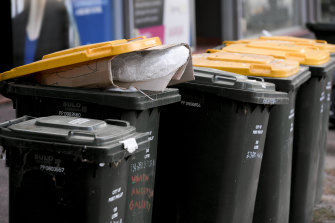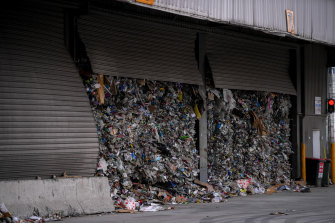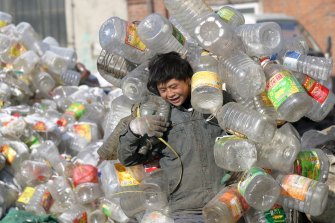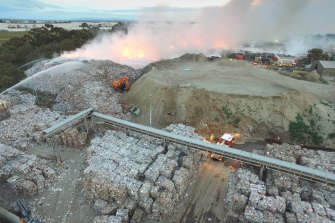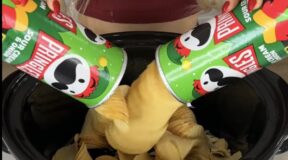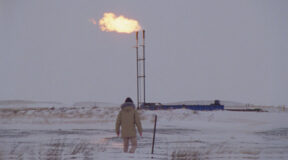Two years ago, nearly two-thirds of “recyclables” Victorians dutifully placed in their yellow-topped bins ended up in landfill.
More than 390,000 tonnes of recyclables were dumped in landfills in 2019-20 – nearly four times the level of half a decade ago.
And tens of thousands of tonnes have been incinerated in more than 100 industrial fires in the past three years, many inadvertently fuelled by all those bottles and boxes that didn’t end up where they were meant to.
Recycling isn’t working.Credit:Eddie Jim
It was bad enough that we almost reached a point where the best thing environmentally conscientious Victorians could do was to throw their recyclables out with the garbage.
Recycling – “closing the loop” – has become the feel-good mantra of the sustainability movement. But the truth is the sector in Victoria has been in a state of crisis since at least 2017.
A combination of the world’s largest recycling market, China, closing its borders in early 2018 to the low-grade recyclables Australia produces and the havoc wreaked by stockpiling, fires and corporate collapses has crippled what could have been a bright future for the industry.
The Cleanaway waste management recycling plant in Laverton.Credit:Eddie Jim
The crisis has provoked the state and federal governments to pump hundreds of millions of dollars into the sector, to make recycling live up to its original promise: giving all that plastic, glass, paper and metal we collect a new life that is clean and self-sustaining.
While it appears the worst of the industry’s failures and excesses are in the past, there is still a reckoning to be had about how and why it all went so wrong, and whether recycling is still truly recoverable in Victoria.
Trash into treasure
While recycling was widely embraced out of a sense of environmental responsibility more than two decades ago, the sector’s boom and bust is about how it became big business.
Popularised by the slogan “reduce, reuse, recycle”, there remains a widely held belief that most of the bottles, boxes and bits of plastic that end up in Victoria’s “resource recovery” waste stream are reborn as new products churned out of local factories. That self-fulfilling loop is correct, up to a point.
The problem was the recycling industry became a victim of its own success – we generated far more recyclables than the market could absorb and the quality of those materials was often poor.
Victorians have embraced recycling as a concept but have proven bad at it in practice. At least 10 per cent of materials collected at the kerbside are classified as “contaminated”.
Rejected by the domestic market as unusable or too expensive to process, these low-value products were actually a high-value commodity on the global export market, particularly in China.
China was once the destination for much of Australia’s recycled waste.Credit:EPA
“Australia was really a collector – we didn’t really process much at all,” said Peter Tamblyn, chief executive of the Australian Council of Recycling.
And what couldn’t be sold overseas or processed began to back up in massive stockpiles in warehouses and industrial yards, to await processing or price changes in the market.
Crash and burn
The realisation that the sector had in fact become a public health and environmental catastrophe in waiting literally exploded into the public consciousness in July 2017, when a spark in a stockpile of recyclables ignited an 11-day blaze that paralysed the northern suburbs of Melbourne.
SKM Recycling had become one of the biggest operators in Victoria off the back of contracts for more than 30 councils to collect and sort recyclables from kerbside bins, with most of that material destined for export.
The fire at the SKM plant in July 2017.Credit:MFB
It had also been amassing huge stockpiles, in potential violation of local planning and environment laws that set limits on the volumes of materials to minimise fire risk and environmental damage.
Firefighters received a shocking instruction in just how rotten recycling had become in the state when they arrived to battle the blaze at the company’s main facility in the northern suburb of Coolaroo.
“SKM was just the most disgusting place you can ever imagine. It was really a sad reflection on how badly the public recycle,” said a firefighter who asked to remain anonymous.
“You had what were meant to be bales of recyclable plastics or whatever, and they’re oozing with baby’s nappies and tampons and needles. We ended up up to our knees in water filled with every unimaginable, horrible thing.”
The devastating impact of the fire on the local community and environment led to the launch of a special taskforce including the Environment Protection Authority, WorkSafe, emergency services and local councils to investigate the industry.
It identified more than 800 resource recovery facilities and rated 162 of them as posing a “high risk”. Dozens of enforcement notices were issued forcing operators to stop accepting waste or clean out the massive backlogs.
Despite the blitz, dozens more fires erupted at recycling and waste facilities over the next two years, including the two worst industrial blazes in decades at an illegal chemical dump in West Footscray in August 2018 and the Campbellfield factory of Bradbury Industrial Services in April 2019.
However, the near death blow to the sector would be delivered from a completely different direction – China.
The sword falls
In early 2018, the world’s biggest export market for recyclables closed its doors under what it called the “National Sword” policy.
For years, China and other developing nations had bought recyclables from Australia considered too contaminated or expensive to be processed into a form that could be reused.
But now China and other developing nations were fed up with these low-grade materials that often turned out to be little better than rubbish, which increasingly ended up clogging its landfills or being illicitly burnt or dumped.
Within months, the global market for recyclables as commodities collapsed and shattered the Victorian “resource recovery” industry.
“When China and then others closed their borders, that changed everything,” Mr Tamblyn said.
The so-called “kerbside value” of most types of plastic, paper and cardboard are still a fraction of the price commanded three years ago during the export boom. Glass and mixed plastics are worth less than nothing, according to Sustainability Victoria.
At the same time, the cost of collecting and processing kerbside recyclables in Victoria continued to spiral, up 50 per cent in the wake of the National Sword policy and the financial collapse of major operators SKM and Glass Recovery Services.
For a time in 2019, nearly half of Victorian councils were forced to ship their recyclables direct to the tip until new, far more costly contractors could be found.
“Frankly, it had reached rock bottom,” said Jeff Angel, director of sustainability organisations the Total Environment Centre and Boomerang Alliance.
The crash exposed the underlying weakness of the domestic recycling market and the hollowness of the sector’s public relations image, which was particularly blatant in Victoria.
“It was a combination of fires, lack of markets for recycled product, contamination in the recycling kerbside bin and distinct lack of action to get good recyclables out into a clean stream,” Mr Angel said.
The hangover has been brutal for the environment, businesses, councils and taxpayers.
In 2019-20, nearly two-thirds of recyclables ended up as garbage in Victoria’s landfills, compared with 16 per cent five years ago, according to Sustainability Victoria.
The bulk of the 390,000 tonnes dumped as waste that year came from purging stockpiles and so-called “safety-related disposal” to prevent fire or environmental contamination.
Corporate collapses and rogue operators have also left taxpayers footing massive bills to clean up abandoned stockpiles created from recyclables that councils, ratepayers and businesses have already paid to have collected and processed responsibly.
In a bizarre irony, the Environment Protection Authority has become one of the biggest polluters in the state due to mountain-sized problems left by defunct industry giants.
The regulator had to pay for the dumping of 145,000 tonnes of contaminated recyclables into landfill after the failure of GRS. Another 300,000 cubic metres of contaminated building waste abandoned at a former recycling facility in Lara will also end up in a tip, at a cost to taxpayers of more than $100 million.
The blame game
The Environment Protection Authority points out that the licensing of recycling facilities “is not the sole responsibility of the EPA and never has been”, with many operators only loosely regulated under local council planning laws.
How that fits with the environmental watchdog’s charter responsibility to “protect the environment and people by preventing and reducing harm from pollution and waste” is another matter.
The explosion in the growth of Victoria’s legitimate waste and recycling industry – and the proliferation of cowboy operators and illegal dumpers – came at exactly the same time as the EPA was cutting back on its regulatory operations.
In the three years before the SKM fire in 2017, the number of inspections conducted by the regulator dropped by 38 per cent. The decline wasn’t because of a lack of resourcing, as staff numbers rose by nearly half over the same period.
“From 2014, EPA adopted a new approach with more targeted inspections based on improved intelligence and risk assessment,” EPA acting chief executive Mark Rossiter told The Age.
Critics point to the roll call of now infamous incidents: SKM, GRS, Lara, West Footscray, Bradbury, and so on.
“The EPA has decided it’s a hammer that it wants a nail to hit. But they won’t go anywhere near the bent nails,” said an industry source, who declined to be named because their business is regulated by the EPA. “They’ll spend an enormous amount of effort cracking down on legitimate businesses over technicalities and call that a win, but when it comes to the real cowboys they hold back because they don’t want to take responsibility for the clean-up or if it means taking down someone’s business.”
Mr Rossiter said: “The goal of the compliance activity is not to close a business but to bring the business into compliance – if it can be.”
The regulator has claimed wins for “health and safety of the Victorian community and environment” by taking over sites such as GRS, Lara and Bradbury, but the action has come only after the operators have collapsed in the wake of repeatedly ignoring EPA commands.
Wendy Farmer, who is a member of a community reference group that advises the EPA, said the regulator had been trying to turn the situation around but was hamstrung against taking proactive action by outdated laws.
“The EPA has not had the power to actually stop things before they happen – to prevent harm. They can see harm, but they can’t do anything about it. They can only act after the harm has been committed,” she said.
Ms Farmer said new powers set to be granted to the EPA in July – after a year-long delay caused by COVID-19 – would change the equation by empowering the EPA to act pre-emptively.
But the problems at the EPA run deeper than something that can be fixed with more powers, according to Liberal MP David Davis.
“Read the current objectives in the act, and they have huge powers. I agree there needs to be reforms. But will that actually change anything?“ said Mr Davis, who authored a dissenting report during a 2019 parliamentary inquiry into the industry.
“New powers won’t do anything to deal with the cultural problems and the EPA’s failure to act using the powers they’ve already got.”
Rise and rise again
While the underlying economics of recycling remain grim, the industry and government are putting on a brave face – backed up with hundreds of millions of dollars of investment in a bid to make recycling more local, safer and economically sustainable.
“Last year I announced a comprehensive overhaul of Victoria’s recycling system to ensure it is fit for purpose in light of industry and market demand within our state, while also responding to changes in global recycling patterns,” Minister for the Environment Lily D’Ambrosio told The Age.
The signature program is the launch of the state’s container deposit scheme in 2023, which is expected to create a new stream of viable “clean” cans and bottles that can be recycled into other products locally. Others are direct investments to boost the state’s depleted capacity to recycle glass and chemical waste in the aftermath of earlier corporate collapses.
Alex Serpo of industry group the Victorian Waste Management Association said more was being spent on recycling than ever before in the state.
“The new regulations we have are the most modern environmental regulations we have in Australia. So the road map is good, we’ve just got to get on with the work between industry and government and create something great.”
The industry is also slated to invest about $1.4 billion in projects, many of which look to finally realise the original, local inspiration of the old slogan to “reduce, reuse, recycle”.
The Total Environment Centre’s Mr Angel said pursuing the kind of “quantum leap” promised for the sector will take years of commitment.
“The absolutely critical thing, which no state or federal government has yet committed to, is recycled content in products – packaging, bottles, longer-lasting products. Because if there is no market for this stuff, it’s not going to go anywhere.”
Start your day informed
Our Morning Edition newsletter is a curated guide to the most important and interesting stories, analysis and insights. Sign up here.
Most Viewed in Politics
Source: Read Full Article
